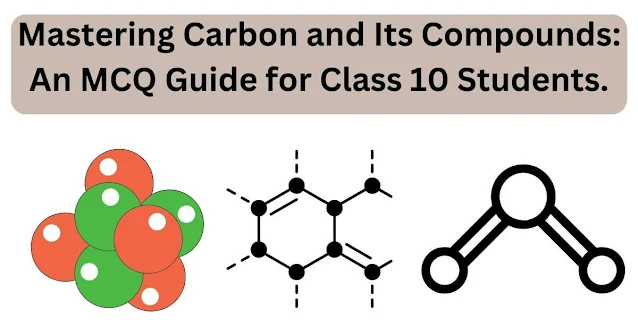Dear Readers, thank you for visiting this thorough blog post that explores the fascinating field of "Carbon and Its Compounds." You've come to the perfect site if you're a Class 10 student getting ready for your exams. Through the use of multiple choice questions (MCQs), we will explore the basic ideas of carbon chemistry and its compounds in this blog post.
The ability of carbon, the fourth most prevalent element in the universe, to produce a very diverse range of compounds has earned it a distinct place in the field of chemistry. The richness and diversity of life as we know it stems from this adaptability. It makes sense that a key section of the book is devoted to the study of carbon and its compounds.
50 Multiple Choice Questions (MCQs) on "Carbon and Its Compounds" for Class 10, along with their answers and explanations. These questions cover various aspects of carbon chemistry and its compounds, and practicing them will undoubtedly help you prepare for your examination and score well. Let's get started!
Carbon And Its Compounds Class 10 MCQs-
1. Which element forms the basis of all organic compounds?
a) Hydrogen
b) Oxygen
c) Carbon
d) Nitrogen
Answer: c) Carbon
Explanation: Carbon is the primary element present in all organic compounds, making it the backbone of organic chemistry.
2. The number of valence electrons in a carbon atom is:
a) 2
b) 4
c) 6
d) 8
Answer: b) 4
Explanation: Carbon has four valence electrons, allowing it to form up to four bonds with other atoms.
3. Which type of bonding is most common in organic compounds?
a) Ionic bonding
b) Covalent bonding
c) Metallic bonding
d) Hydrogen bonding
Answer: b) Covalent bonding
Explanation: Organic compounds primarily involve covalent bonding, where atoms share electrons to form stable molecules.
4. Which of the following is a hydrocarbon with a single bond between carbon atoms?
a) Alkane
b) Alkene
c) Alkyne
d) Aromatic compound
Answer: a) Alkane
Explanation: Alkanes are hydrocarbons with single bonds between carbon atoms.
5. The general formula of alkanes is:
a) CnH2n
b) CnH2n+2
c) CnH2n-2
d) CnHn
Answer: b) CnH2n+2
Explanation: The general formula of alkanes is CnH2n+2, where "n" represents the number of carbon atoms.
6. Which organic compound is represented by the formula C2H4?
a) Ethane
b) Ethene
c) Ethyne
d) Methane
Answer: b) Ethene
Explanation: C2H4 is the molecular formula of ethene, which is an alkene.
7. The process of converting alkenes into alkanes is called:
a) Hydrogenation
b) Halogenation
c) Combustion
d) Polymerization
Answer: a) Hydrogenation
Explanation: Hydrogenation is the process of adding hydrogen to alkenes to convert them into alkanes.
8. Which of the following compounds is responsible for the greenhouse effect?
a) Carbon monoxide
b) Carbon dioxide
c) Methane
d) Ethanol
Answer: b) Carbon dioxide
Explanation: Carbon dioxide is a greenhouse gas that contributes to the greenhouse effect, leading to global warming.
9. The functional group present in alcohols is:
a) -OH
b) -COOH
c) -NH2
d) -CHO
Answer: a) -OH
Explanation: Alcohols have the functional group -OH (hydroxyl group).
10. What is the name of the compound CH3-CH2-O-CH2-CH3?
a) Ethyl ether
b) Ethanol
c) Ethanoic acid
d) Ethene
Answer: a) Ethyl ether
Explanation: The compound CH3-CH2-O-CH2-CH3 is ethyl ether, which has the formula C2H5OC2H5.
11. The process of converting an alcohol into an alkene is called:
a) Fermentation
b) Dehydration
c) Esterification
d) Saponification
Answer: b) Dehydration
Explanation: Dehydration is the process of removing water from an alcohol, resulting in the formation of an alkene.
12. Which gas is produced during the fermentation of sugars by yeast?
a) Oxygen
b) Nitrogen
c) Carbon dioxide
d) Hydrogen
Answer: c) Carbon dioxide
Explanation: During fermentation, yeast converts sugars into ethanol and carbon dioxide.
13. The process of converting fats and oils into soap is known as:
a) Fermentation
b) Saponification
c) Esterification
d) Hydrogenation
Answer: b) Saponification
Explanation: Saponification is the process of hydrolyzing fats and oils using a strong base to produce soap and glycerol.
14. Which type of carbon compounds contains a carbonyl group (C=O)?
a) Aldehyde
b) Ketone
c) Ester
d) Carboxylic acid
Answer: b) Ketone
Explanation: Ketones contain a carbonyl group (C=O) bonded to two carbon atoms.
15. The functional group present in carboxylic acids is:
a) -OH
b) -COOH
c) -NH2
d) -CHO
Answer: b) -COOH
Explanation: Carboxylic acids have the functional group -COOH (carboxyl group).
16. Which compound is responsible for the pungent smell of garlic?
a) Ethanol
b) Acetic acid
c) Methanoic acid
d) Allicin
Answer: d) Allicin
Explanation: Allicin is a compound present in garlic that is responsible for its pungent smell and medicinal properties.
17. The process of adding chlorine or bromine to an alkane is called:
a) Hydrogenation
b) Halogenation
c) Combustion
d) Saponification
Answer: b) Halogenation
Explanation: Halogenation is the process of adding halogens like chlorine or bromine to an alkane.
18. The polymerization of ethene results in the formation of:
a) Polyethylene
b) Polypropylene
c) PVC (Polyvinyl chloride)
d) Teflon
Answer: a) Polyethylene
Explanation: Polymerization of ethene yields polyethylene, a widely used plastic.
19. Which gas is released when calcium carbonate (CaCO3) reacts with hydrochloric acid (HCl)?
a) Oxygen
b) Carbon dioxide
c) Hydrogen
d) Nitrogen
Answer: b) Carbon dioxide
Explanation: Calcium carbonate reacts with hydrochloric acid to form calcium chloride, water, and carbon dioxide.
20. The process of burning a carbon compound in the presence of oxygen to produce carbon dioxide and water is called:
a) Fermentation
b) Combustion
c) Polymerization
d) Saponification
Answer: b) Combustion
Explanation: Combustion is the chemical process of burning a carbon compound in the presence of oxygen.
21. Which of the following is a saturated hydrocarbon?
a) Ethane
b) Ethene
c) Ethyne
d) Methane
Answer: d) Methane
Explanation: Methane is a saturated hydrocarbon as it contains only single bonds between carbon atoms.
22. Which compound is used as an antiseptic to clean wounds?
a) Ethanol
b) Methanol
c) Propanol
d) Chloroform
Answer: a) Ethanol
Explanation: Ethanol is commonly used as an antiseptic to clean wounds due to its disinfectant properties.
23. The process of converting an alkene into an alkane is called:
a) Hydrogenation
b) Dehydration
c) Esterification
d) Saponification
Answer: a) Hydrogenation
Explanation: Hydrogenation is the process of adding hydrogen to an alkene to convert it into an alkane.
24. Which of the following is the correct IUPAC name for CH3-CH2-COOH?
a) Ethyl ethanoate
b) Ethanoic acid
c) Ethyl acetate
d) Ethene
Answer: b) Ethanoic acid
Explanation: CH3-CH2-COOH is ethanoic acid, also known as acetic acid.
carbon and its compounds class 10 mcq online test
25. What is the name of the compound CH3-CH2-CHO?
a) Ethanoic acid
b) Ethene
c) Ethanal
d) Ethanol
Answer: c) Ethanal
Explanation: CH3-CH2-CHO is ethanal, also known as acetaldehyde.
26. The process of converting alkenes into alcohols is called:
a) Fermentation
b) Hydrogenation
c) Esterification
d) Halogenation
Answer: b) Hydrogenation
Explanation: Hydrogenation is the process of adding hydrogen to alkenes to convert them into alcohols.
27. The monomer unit of polypropylene is derived from:
a) Propene
b) Ethene
c) Propyne
d) Propionaldehyde
Answer: a) Propene
Explanation: Polypropylene is derived from the monomer unit propene.
28. What is the name of the compound CH3-CH2-CH2-CH3?
a) Ethanol
b) Propane
c) Ethane
d) Butane
Answer: b) Propane
Explanation: CH3-CH2-CH2-CH3 is propane, which contains three carbon atoms.
29. The functional group present in esters is:
a) -OH
b) -COOH
c) -COO-
d) -CHO
Answer: c) -COO-
Explanation: Esters have the functional group -COO-, which is known as the ester group.
30. Which of the following is the correct IUPAC name for CH3-CH2-CH2-COOH?
a) Butanoic acid
b) Propanoic acid
c) Butyric acid
d) Butyl acetate
Answer: a) Butanoic acid
Explanation: CH3-CH2-CH2-COOH is butanoic acid, which contains four carbon atoms.
31. The process of converting alcohols into carboxylic acids is called:
a) Fermentation
b) Dehydration
c) Esterification
d) Oxidation
Answer: d) Oxidation
Explanation: Oxidation of alcohols leads to the formation of carboxylic acids.
32. Which compound is used as a solvent for paints and varnishes?
a) Methanol
b) Propanol
c) Acetone
d) Toluene
Answer: d) Toluene
Explanation: Toluene is commonly used as a solvent for paints and varnishes.
33. Which gas is produced when ethanoic acid reacts with sodium carbonate?
a) Oxygen
b) Carbon dioxide
c) Hydrogen
d) Nitrogen
Answer: b) Carbon dioxide
Explanation: Ethanoic acid reacts with sodium carbonate to produce sodium ethanoate, water, and carbon dioxide.
34. The process of converting alcohols into ethers is called:
a) Fermentation
b) Esterification
c) Dehydration
d) Substitution
Answer: c) Dehydration
Explanation: Dehydration of alcohols leads to the formation of ethers.
35. Which of the following compounds has a pleasant, fruity smell and is used as a flavoring agent?
a) Methanol
b) Ethanol
c) Methanal
d) Ethyl ethanoate
Answer: d) Ethyl ethanoate
Explanation: Ethyl ethanoate has a pleasant, fruity smell and is used as a flavoring agent in various food products.
36. The monomer unit of polyvinyl chloride (PVC) is derived from:
a) Vinyl chloride
b) Ethene
c) Propene
d) Acetylene
Answer: a) Vinyl chloride
Explanation: The monomer unit of PVC is derived from vinyl chloride.
37. Which compound is used as an antifreeze in automobile radiators?
a) Ethanol
b) Ethylene glycol
c) Methanol
d) Propanol
Answer: b) Ethylene glycol
Explanation: Ethylene glycol is used as an antifreeze in automobile radiators due to its ability to lower the freezing point of water.
38. Which of the following compounds is responsible for the sweet taste of fruits?
a) Ethanoic acid
b) Ethanol
c) Methanoic acid
d) Ethyl ethanoate
Answer: d) Ethyl ethanoate
Explanation: Ethyl ethanoate is responsible for the sweet smell and taste of fruits.
39. The process of converting an alcohol into an ester is called:
a) Fermentation
b) Dehydration
c) Esterification
d) Halogenation
Answer: c) Esterification
Explanation: Esterification is the process of combining an alcohol and a carboxylic acid to form an ester.
40. Which compound is used as an anesthetic in medical procedures?
a) Ethanol
b) Methanol
c) Chloroform
d) Propanol
Answer: c) Chloroform
Explanation: Chloroform has been used as an anesthetic in medical procedures, though it is no longer commonly used due to safety concerns.
41. The general formula of alcohol is:
a) CnH2n
b) CnH2n+2
c) CnH2n-2
d) CnHn
Answer: b) CnH2n+2
Explanation: The general formula of alcohols is CnH2n+2, where "n" represents the number of carbon atoms.
42. Which gas is produced when ethanoic acid reacts with sodium hydrogen carbonate (baking soda)?
a) Oxygen
b) Carbon dioxide
c) Hydrogen
d) Nitrogen
Answer: b) Carbon dioxide
Explanation: Ethanoic acid reacts with sodium hydrogen carbonate to produce sodium ethanoate, water, and carbon dioxide.
43. The process of converting an alkane into alcohol is called:
a) Fermentation
b) Hydrogenation
c) Esterification
d) Halogenation
Answer: b) Hydrogenation
Explanation: Hydrogenation is the process of adding hydrogen to an alkane to convert it into an alcohol.
44. Which gas is released during the fermentation of glucose by yeast?
a) Oxygen
b) Nitrogen
c) Carbon dioxide
d) Hydrogen
Answer: c) Carbon dioxide
Explanation: During fermentation, yeast converts glucose into ethanol and carbon dioxide.
45. The process of converting alkenes into alkynes is called:
a) Fermentation
b) Hydrogenation
c) Halogenation
d) Polymerization
Answer: d) Polymerization
Explanation: Polymerization is the process of combining monomers to form larger molecules, such as converting alkenes into alkynes.
46. The functional group present in amines is:
a) -OH
b) -COOH
c) -NH2
d) -CHO
Answer: c) -NH2
Explanation: Amines have the functional group -NH2, which consists of a nitrogen atom bonded to two hydrogen atoms.
47. What is the name of the compound CH3-CH2-NH2?
a) Ethyl amine
b) Ethanoic acid
c) Ethyne
d) Ethanol
Answer: a) Ethyl amine
Explanation: CH3-CH2-NH2 is ethyl amine, which contains an amino group (-NH2).
48. The monomer unit of polyethylene is derived from:
a) Ethene
b) Propene
c) Ethanol
d) Butene
Answer: a) Ethene
Explanation: The monomer unit of polyethylene is derived from ethene.
49. Which compound is used as a disinfectant for water purification?
a) Methanol
b) Ethanol
c) Ethanoic acid
d) Chlorine
Answer: d) Chlorine
Explanation: Chlorine is commonly used as a disinfectant for water purification.
50. The process of converting aldehydes and ketones into alcohols is called:
a) Fermentation
b) Reduction
c) Esterification
d) Halogenation
Answer: b) Reduction
Explanation: Reduction is the process of adding hydrogen to aldehydes and ketones to convert them into alcohol.
Carbon And Its CompoundsClass 10 MCQ Pdf.
With these 50 MCQs and their explanations, you now have a comprehensive practice resource for mastering the concepts of "Carbon and Its Compounds" for your Class 10 examination. Remember to approach your studies with dedication, practice regularly, and seek further clarification if needed. Best of luck, and may you achieve great success in your exams!



%20(1).jpg)
.jpg)






If you have any doubts please comment